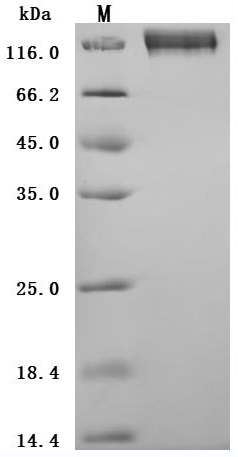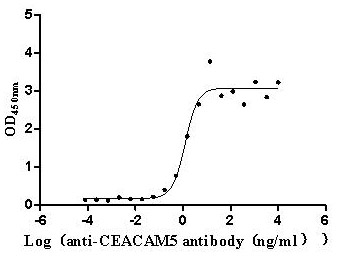This Human CEACAM5 recombinant protein was produced in mammalian cell, where the gene sequence encoding Human CEACAM5 (expression area: 35-685aa; mutation site: E398K) was expressed with the C-terminal 10xHis tag. The purity of this CEACAM5 protein was greater than 95%. The activity was validated.
CEACAM5 (known as CEA, CD66e) belongs to the carcinoembryonic antigen CEACAM subfamily of the immunoglobulin superfamily. It is a homodimeric protein and cell surface glycoprotein that is overexpressed in many cancers and has been implicated in adhesion and invasion.
CEACAM5 is predominantly expressed by epithelial cells and is differentially expressed between species. In normal adult tissues, CEACAM5 is located in the stomach, tongue, esophagus, cervix, sweat glands and prostate. High CEACAM5 can be detected in tumor cells of advanced non-small cell lung cancer, small cell lung cancer, pancreatic cancer, gallbladder cancer, bladder cancer, mucinous ovarian cancer, endometrial cancer, colorectal cancer and gastric cancer.
CEACAM5 protein has a long history as a tumor biomarker. In 1965, researchers first discovered that CEA can be used as a marker of colorectal cancer, suggesting its significance in cancer research. The development of highly active and stable mammalian CEACAM5 protein will help to better study the mechanism and signaling pathway of CEACAM5 in the human body and help the research of related clinical drugs.








